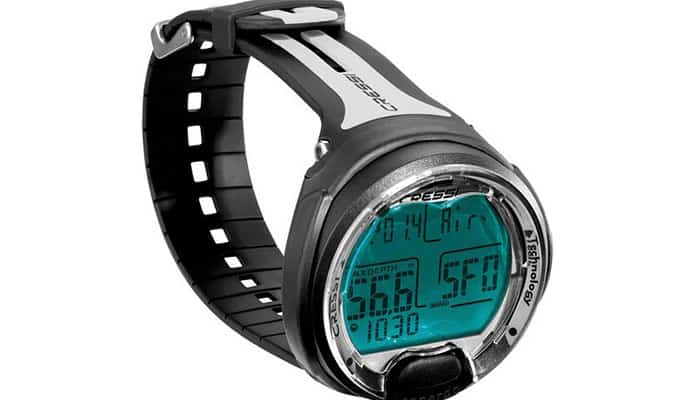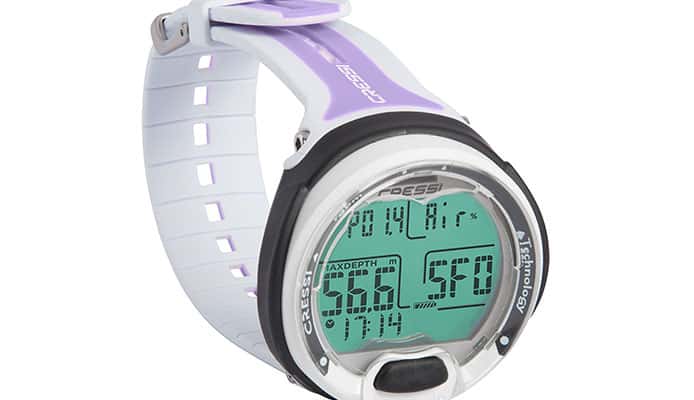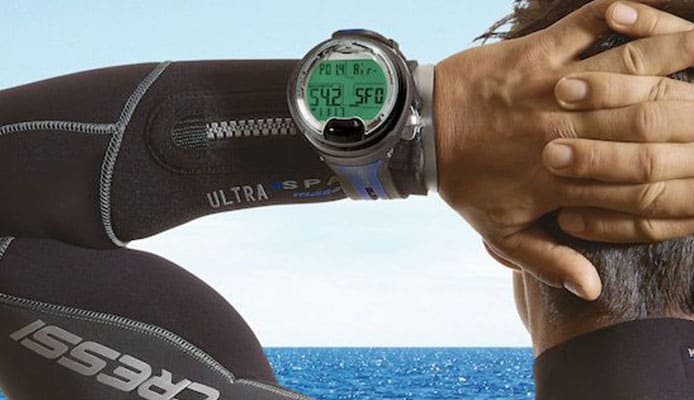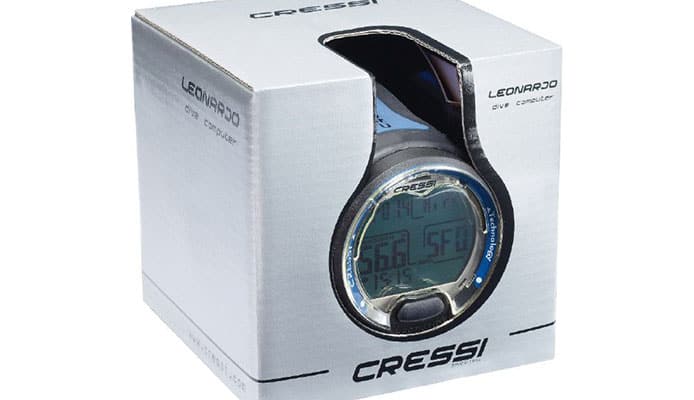Cressi Leonardo
- What Makes This Dive Computer Stand Out
- Easy to set up and use
- Adjustable Alarms
- Visually attractive and understandable data
- Sportswear design
- Can be used in metric or imperial units.
- Affordable price
Features
The Cressi Leonardo is a single button set up the diving computer, which lets you set the Air, Nitrox and Gauge modes. With a capacity to collect data over 70 hours of diving or 60 dives, which paired with the non-included diving data log, will allow you to graph your process. Even if you don’t buy the diving data log software, the diving computer provides depth, decompression status, maximum depth, bottom time, descent and ascent rates, ambient temperatures, surface intervals, and warning points.
This dive computer offers specialized features for safety and for expert divers to use. It comes with the modified 9-tissue Haldane Algorithm, which can be customizable depending on the safety factor the diver wishes to use. It includes an automatic acoustic and visual alarm by brightening the screen, which can be adjusted according to the diver’s needs.
The gauge mode included in the Leonardo allows for beginners to start using the computer without needing a background or experience in using dive watches since it will display, current depth, maximum depth, dive time, and temperature. This without the benefit of instantly knowing levels of PO2 and mixes with decompression tables.
As a complement to the computational advantages, the Leonard Dive Computer offers, it has real-time tracking of CNS oxygen toxicity, with a graphic indicator. As well as FO2 and PO2 level adjustable depending on the diver’s preferences. It has a high-definition display, with character size optimized for ease of use in emergencies. The back-lit display is activated by the alarm system or by pressing the button.
Specifications
Length: 2.63”
Thickness: 1.06”
Weight: 4.76 ounces
Altitude up to 12,100 ft.
Replaceable CR2430 battery
User Experience
Ease of use
The Cressi Leonardo is extremely easy to use, as soon as it’s physical set-up with the push of its single-button you can start the software set up. There you can decide to use either the metric or imperial system, for both the measurements and the temperature. For beginners, this allows them to easily set up the safety factor, nitrox, and air levels, which will make the experience of using a diving computer for the first time simpler.
The way to use it inside the water is pretty straight forward as well, since it only has one button, and the commands depend on the times you push it. You can turn the display back-light with a long press of the button which will show you all of the real-time information about your dive. Whenever you start to ascend or dive too fast the computer starts beeping and using light signals to give you a heads up for you to slow down, making your dive much safer.
One of the features the Leonardo does come with, is air integration, meaning that it will display the parameters of your dive, but can’t calculate how long you can dive or continue underwater according to the amount of air left in the tank. This is not a huge problem since air tanks are usually refilled just before the dive, but for the absolute beginner diver, this should be a practical feature to include.
Functionality
The Leonardo Dive Computer has great functionality since it’s a single button computer with the added benefit of having the form factor of a watch. It’s easily programmable since the button has only two basic functions in the water and outside. When setting up the computer, you use a long press to edit something in the parameters offered by the computer, and the short press is to change menus. When underwater, a long press will turn on the backlight for a couple of seconds.
One of the only downsides to the functionality of the computer is the length of the wrist band, which is way too long for the average human wrist size. This is not primordial for functionality, but it’s still annoying to have the remaining wrist band just dangling.
This dive computer comes with a new algorithm developed by Cressi, known as RGBM, which was developed based on the Haldane model with the input of professionals and experts in diving. The algorithm has been designed to make safe decompression calculations for multiple dives while supplying real-time information about depth, dive time, decompression status, ascent rate, and surface interval times. It measures the nitrogen absorption and releases taking into account the number of inert gases in the mixtures that can be used.
Dive logs
As mentioned before, the Leonardo offers a built-in memory for around 60 dives or 70 hours, which for the common user should be more than enough, but for the usual diver, it can be small. This could be fixed by the use of a data dive log, which Cressi offers but is not included with the Leonardo. You have to buy the logger to keep track of the data you collect and to plan for the next dives. This can be fixed by using open source software such as subsurface, which is free, but it has not been optimized for the hardware.
Even if it is a small memory, it has great functionality since it will display data in a user-friendly way, with all the events you will probably need to analyze your dive.
Performance
Leonardo offers great performance, especially given its price point, which is really competitive and even affordable for the features it has. It will offer the expected performance both inside the water and outside, it can be used as a slightly big everyday timekeeping watch, or a diving computer as soon as you hit the water.
Since most of its features are adjustable to the user’s needs, Leonardo’s performance is great for experienced divers who dive at different altitudes or those who like traveling around the world. It’s easy to carry or travel with since it can be used as an everyday watch and the form factor will have no impact on your luggage.
Overall Rating
- Materials: 100%– Made to withstand high pressures and deep diving, the Leonardo is a rugged diving computer the size of a big watch.
- Design: 98%– Even do its design is optimized for its functionality, the length of the wrist is way too long and the pin to keep it on you won’t make you feel safe about losing it.
- Functions: 95%– It has all of the functionality necessary for successful and safe guided diving, but paying extra for the diving log software is a con.
Pros:
- Easy to use
- Affordable
- Adjustable to the user’s needs.
Cons:
- Small memory
- Does not include diving log software.
You might also like: Stuhrling Aquadiver Dive Watch Review
Globo Surf Overview
The Cressi Leonardo is a rugged dive computer with the form size of a big watch, which has all the features necessary to have a safe dive. It is a single button diving computer, which makes it simple to use, set up, and maintain, which allows you to adjust the Air, Nitrox, and Gauge modes. It offers a high definition screen with backlighting for great visualization even in dark or muddy environments.
For the user’s peace of mind and enjoyment of the amazing experience of diving, the Leonardo comes with alarms, made up of sounds and visual lights to stop you from ascending too fast. It also includes enough memory for around 60 dives or 70 hours of data you can analyze with open source software or acquiring the additional interface offered by Cressi.
This makes the Leonardo one of the best choices for beginners and experts alike since it is affordable, rugged, and has the size of a big watch. Without sacrificing all the functionality, the diver needs for safety and to make the diving experience as pleasant as possible. With the added benefit you can use it as an everyday timekeeping watch.
Single Scuba Products Reviews:
- Suunto D4i Novo Dive Computer Review
- Aqua Lung I100 Dive Computer Review
- Seiko SKX007K Dive Watch Review
- Luminox 3001 Navy Seal Dive Watch Review
- Orient Men’s Ray II Dive Watch Review
- Suunto D4F Black Freedive Computer Review
- Mares Nemo Wide Dive Computer Review
- Citizen Watch BM8180-03E Dive Watch Review
- Invicta 8926OB Pro Diver Dive Watch Review
- Mares Puck Pro Dive Computer Review
- Aqua Lung I300 Dive Computer Review







